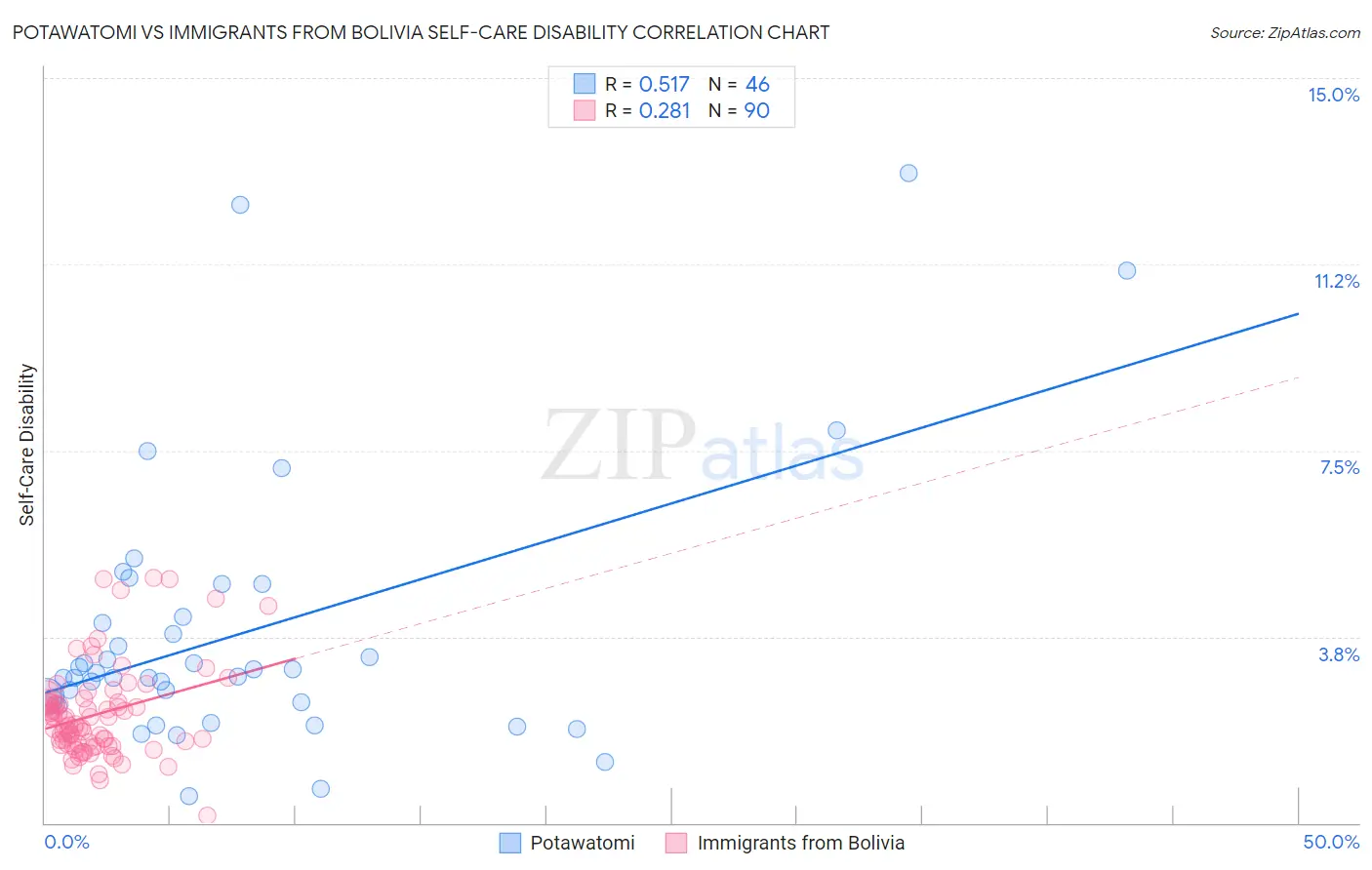Potawatomi vs Immigrants from Bolivia Self-Care Disability
COMPARE
Potawatomi
Immigrants from Bolivia
Self-Care Disability
Self-Care Disability Comparison
Potawatomi
Immigrants from Bolivia
2.6%
SELF-CARE DISABILITY
0.3/ 100
METRIC RATING
257th/ 347
METRIC RANK
2.2%
SELF-CARE DISABILITY
100.0/ 100
METRIC RATING
7th/ 347
METRIC RANK
Potawatomi vs Immigrants from Bolivia Self-Care Disability Correlation Chart
The statistical analysis conducted on geographies consisting of 117,741,431 people shows a substantial positive correlation between the proportion of Potawatomi and percentage of population with self-care disability in the United States with a correlation coefficient (R) of 0.517 and weighted average of 2.6%. Similarly, the statistical analysis conducted on geographies consisting of 158,671,201 people shows a weak positive correlation between the proportion of Immigrants from Bolivia and percentage of population with self-care disability in the United States with a correlation coefficient (R) of 0.281 and weighted average of 2.2%, a difference of 22.2%.

Self-Care Disability Correlation Summary
| Measurement | Potawatomi | Immigrants from Bolivia |
| Minimum | 0.54% | 0.14% |
| Maximum | 13.1% | 4.9% |
| Range | 12.5% | 4.8% |
| Mean | 3.8% | 2.2% |
| Median | 3.0% | 2.0% |
| Interquartile 25% (IQ1) | 2.4% | 1.6% |
| Interquartile 75% (IQ3) | 4.2% | 2.4% |
| Interquartile Range (IQR) | 1.7% | 0.85% |
| Standard Deviation (Sample) | 2.7% | 0.92% |
| Standard Deviation (Population) | 2.7% | 0.91% |
Similar Demographics by Self-Care Disability
Demographics Similar to Potawatomi by Self-Care Disability
In terms of self-care disability, the demographic groups most similar to Potawatomi are Nonimmigrants (2.6%, a difference of 0.070%), Immigrants from Belarus (2.6%, a difference of 0.14%), Chippewa (2.6%, a difference of 0.18%), Immigrants from Central America (2.6%, a difference of 0.20%), and Arapaho (2.6%, a difference of 0.20%).
| Demographics | Rating | Rank | Self-Care Disability |
| Portuguese | 0.4 /100 | #250 | Tragic 2.6% |
| Immigrants | Liberia | 0.4 /100 | #251 | Tragic 2.6% |
| Immigrants | Bangladesh | 0.4 /100 | #252 | Tragic 2.6% |
| Immigrants | Haiti | 0.3 /100 | #253 | Tragic 2.6% |
| Haitians | 0.3 /100 | #254 | Tragic 2.6% |
| Tsimshian | 0.3 /100 | #255 | Tragic 2.6% |
| Immigrants | Central America | 0.3 /100 | #256 | Tragic 2.6% |
| Potawatomi | 0.3 /100 | #257 | Tragic 2.6% |
| Immigrants | Nonimmigrants | 0.3 /100 | #258 | Tragic 2.6% |
| Immigrants | Belarus | 0.2 /100 | #259 | Tragic 2.6% |
| Chippewa | 0.2 /100 | #260 | Tragic 2.6% |
| Arapaho | 0.2 /100 | #261 | Tragic 2.6% |
| Shoshone | 0.2 /100 | #262 | Tragic 2.7% |
| Immigrants | Latin America | 0.2 /100 | #263 | Tragic 2.7% |
| Immigrants | Iran | 0.2 /100 | #264 | Tragic 2.7% |
Demographics Similar to Immigrants from Bolivia by Self-Care Disability
In terms of self-care disability, the demographic groups most similar to Immigrants from Bolivia are Bolivian (2.2%, a difference of 0.050%), Immigrants from Nepal (2.2%, a difference of 0.18%), Filipino (2.2%, a difference of 0.21%), Zimbabwean (2.2%, a difference of 0.46%), and Sudanese (2.2%, a difference of 1.4%).
| Demographics | Rating | Rank | Self-Care Disability |
| Yup'ik | 100.0 /100 | #1 | Exceptional 1.9% |
| Immigrants | India | 100.0 /100 | #2 | Exceptional 2.0% |
| Thais | 100.0 /100 | #3 | Exceptional 2.1% |
| Immigrants | Singapore | 100.0 /100 | #4 | Exceptional 2.1% |
| Zimbabweans | 100.0 /100 | #5 | Exceptional 2.2% |
| Filipinos | 100.0 /100 | #6 | Exceptional 2.2% |
| Immigrants | Bolivia | 100.0 /100 | #7 | Exceptional 2.2% |
| Bolivians | 100.0 /100 | #8 | Exceptional 2.2% |
| Immigrants | Nepal | 100.0 /100 | #9 | Exceptional 2.2% |
| Sudanese | 100.0 /100 | #10 | Exceptional 2.2% |
| Immigrants | South Central Asia | 100.0 /100 | #11 | Exceptional 2.2% |
| Immigrants | Ethiopia | 100.0 /100 | #12 | Exceptional 2.2% |
| Ethiopians | 100.0 /100 | #13 | Exceptional 2.2% |
| Luxembourgers | 100.0 /100 | #14 | Exceptional 2.2% |
| Okinawans | 100.0 /100 | #15 | Exceptional 2.2% |